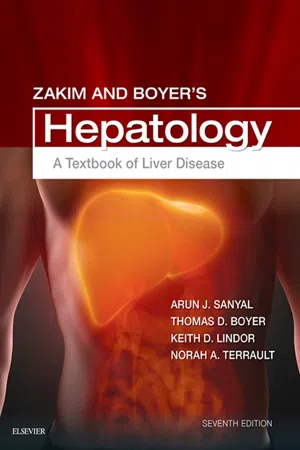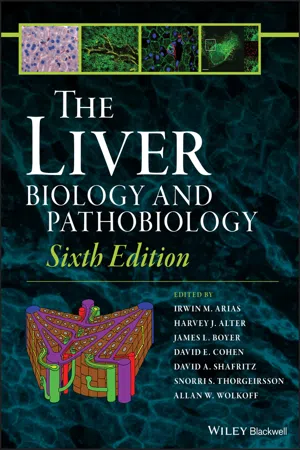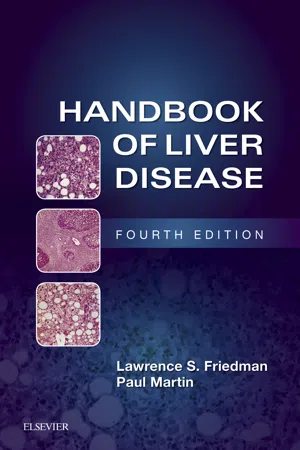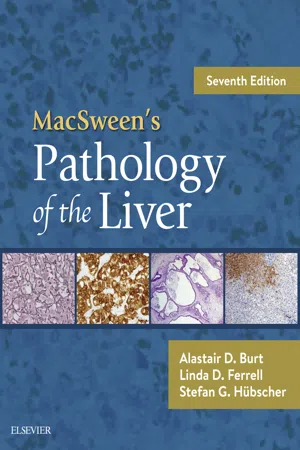Biological Sciences
Hepatitis D
Hepatitis D, also known as delta hepatitis, is a liver infection caused by the hepatitis D virus (HDV). It is considered the most severe form of viral hepatitis, as it can only occur in individuals who are already infected with hepatitis B. HDV is transmitted through contact with infected blood or bodily fluids, and the infection can lead to a more severe liver disease than hepatitis B alone.
Written by Perlego with AI-assistance
11 Key excerpts on "Hepatitis D"
- eBook - ePub
- Douglas D. Richman, Richard J. Whitley, Frederick G. Hayden, Douglas D. Richman, Richard J. Whitley, Frederick G. Hayden, Douglas D. Richman, Richard J. Whitley, Frederick G. Hayden(Authors)
- 2016(Publication Date)
- ASM Press(Publisher)
58 Hepatitis D MARIO RIZZETTO, ANTONINA SMEDILE, AND ALESSIA CIANCIO Hepatitis D virus (HDV) is unique in animal virology and pathology. It has a circular RNA genome of the smallest size among human viruses, requires the hepatitis B surface antigen (HBsAg) capsid provided by the hepatitis B virus (HBV) to assemble into infectious virions, parasitizes the transcriptional machinery of the host by hijacking cellular RNA polymerases to replicate its RNA genome, and is replicated by a rolling circle mechanism unknown in mammalian cells. HDV is a defective RNA virus recognized in the late 1970s as a new cause of hepatitis. Its discovery followed the description in Torino of a new antigen, named delta, in the liver of patients with chronic HBV liver disease (1). Subsequent studies at the National Institution of Health US revealed that the delta antigen was the expression of a new hepatitis virus, which was named HDV. The term delta virus and delta hepatitis are still used as synonyms of HDV and Hepatitis D. Cloning and sequencing of the viral genome in 1986 established the peculiar features that make HDV unique among animal viruses (2, 3). The host range of HDV infections includes humans, chimpanzees, and woodchucks carrying the woodchuck hepatitis virus (4). Infection is present worldwide (5). Carriers of the HBsAg superinfected by HDV are the major victims of the infection and the reservoir of the virus. HDV infection almost invariably results in liver damage, often a severe and progressive hepatitis conducive to cirrhosis (6), and is the most severe form of chronic viral liver disorders. Vaccination against the HBV has reduced the spread of HDV in industrialized countries over the last 20 years. However, Hepatitis D is returning to Western Europe through immigration from regions where HDV remains endemic and is being rediscovered in the developing world, where it has a major medical impact in many areas of Africa, Asia, and South America - eBook - ePub
Zakim and Boyer's Hepatology
A Textbook of Liver Disease E-Book
- Thomas D. Boyer, Keith D Lindor, Arun J. Sanyal, Norah A Terrault(Authors)
- 2016(Publication Date)
- Elsevier(Publisher)
34Hepatitis D
Theo Heller, Christopher Koh, Jeffrey S. GlennAbbreviationsALT alanine aminotransferaseHBsAg hepatitis B surface antigenHBV hepatitis B virusHCC hepatocellular carcinomaHCV hepatitis C virusHDV Hepatitis Delta virusIntroduction
Hepatitis Delta virus (HDV) is the sole member of the genus Deltavirus and is estimated to infect 15 million to 20 million people of all age groups worldwide. HDV is a human pathogen, and HDV infection can exist as an acute or chronic infection and occurs only in individuals who have active hepatitis B virus (HBV) infection. It is a defective RNA virus that requires hepatitis B surface antigen for assembly and transmission. It is currently the only chronically infecting human hepatitis virus that is without an FDA-approved therapy. Although rare, hepatitis D is known to be the most rapidly progressive viral hepatitis and the most likely to lead to cirrhosis, and as such may be viewed as the most severe form of human viral hepatitis.Historical Perspective
The initial identification of HDV dates back to the mid-1970s during an investigation of a group of patients with HBV infection who developed severe hepatitis.1 During this investigation a novel nuclear antigen, coined the delta antigen , was discovered and initially thought to be a hepatitis B antigen. In subsequent chimpanzee experiments the delta antigen was identified as a structural component of a distinct pathogen that required HBV for its life cycle.2 , 3 The precise molecular origin of HDV remains a subject of speculation.4Since the discovery of HDV, HDV infection has been found in all age groups worldwide. Worldwide prevalence data, although improving through increased awareness, testing, and reporting, are still limited, and most reports are based on studies of seroprevalence of anti-HDV in hepatitis B surface antigen (HBsAg)-positive patients (Fig. 34-1 - eBook - ePub
- Howard C. Thomas, Anna S. Lok, Stephen A. Locarnini, Arie J. Zuckerman, Howard C. Thomas, Anna S. F. Lok, Stephen A. Locarnini, Arie J. Zuckerman(Authors)
- 2013(Publication Date)
- Wiley-Blackwell(Publisher)
Section V Hepatitis D VirusPassage contains an image Chapter 27 Structure and molecular virology Francesco Negro Divisions of Clinical Pathology and Gastroenterology and Hepatology, University Hospital, Geneva, Switzerland
SummaryThe Hepatitis D virus (HDV) is a defective RNA infectious agent needing the presence of the hepatitis B virus (HBV) to complete its life cycle. HDV is present worldwide, but the distribution pattern is not uniform. Different viral strains are classified into eight genotypes found in specific geographical areas and often associated with severe disease outcome. The HDV particle is composed of an envelope, provided by the helper HBV, surrounding the 1.7 kB RNA genome and the HDV antigen. Replication occurs in the hepatocyte nucleus via a rolling-circle mechanism that leads to a full-length, complementary RNA as a replication intermediate. Since HDV does not possess the encoding capability for a RNA polymerase, replication is brought about by cellular polymerases.Introduction
The HDV discovery dates back to 1977, when Rizzetto and coworkers reported the detection of a novel nuclear antigen – initially dubbed the delta antigen – in the hepatocytes of patients with a severe form of chronic hepatitis B [1,2]. Later experiments in chimpanzees showed that the Hepatitis Delta (or D) antigen (HDAg) was a structural component of a transmissible virus requiring the simultaneous presence of HBV to complete its life cycle. This premise is necessary to understand fully the unusual structure of HDV particles, which are composed of HBV envelope proteins surrounding a ribonucleoprotein inner structure, comprising the HDAg and the HDV RNA genome [3]. Initially known as “delta agent” or hepatitis “delta” virus, currently the term “Hepatitis D virus” is preferred, even if “delta” is still frequently used. - James S. Dooley, Anna S. Lok, Guadalupe Garcia-Tsao, Massimo Pinzani, James S. Dooley, Anna S. F. Lok, Guadalupe Garcia-Tsao, Massimo Pinzani(Authors)
- 2018(Publication Date)
- Wiley-Blackwell(Publisher)
[2] . In 1983, the delta agent was renamed Hepatitis Delta virus (HDV) and the disease it causes Hepatitis D. The association of HDV with hepatitis B virus (HBV) stems from the fact that HDV is a hybrid virus that incorporates the hepatitis B virus surface antigen (HBsAg) as its envelope protein. As a consequence, HDV can establish infection only in individuals who simultaneously harbour HBV. Infection with HDV is found worldwide and is associated with the most severe forms of acute, including fulminant, hepatitis and chronic liver disease in HBsAg‐positive subjects.Hepatitis D virus (Table 22.1 )Characteristics of Hepatitis D virus (HDV)Table 22.1Classification Genus Deltavirus Defective Requires the helper function of HBV Virion 35–37 nm particle, coated by HBsAg Genome 1.7 kb single‐stranded, circular RNA, negative polarity Open reading frame One, encoding HDAg Genotypes Eight Pathogenicity High, acute and chronic hepatitis Distribution Worldwide, 15 million HBsAg carriers coinfected with HDV HDV is a defective RNA virus that requires the helper function of HBV for virion assembly, release, and transmission [3] . HDV does not resemble any known transmissible agent of animals, but shares similarities with plant viroids. Owing to its uniqueness, it has been classified as the type species of a separate genus, Deltavirus [4] . HDV is the smallest animal virus, 35–37 nm in diameter, and the only one to possess a circular RNA genome, which contains a single‐stranded negative RNA of about 1700 nucleotides (Fig. 22.1 ) [5] . The HDV genome encodes a single structural protein, the Hepatitis Delta antigen (HDAg). Within the virus particle is a nucleocapsid, a ribonucleoprotein complex formed by the RNA genome with the HDAg [3] . There are two related forms of HDAg, the short (HDAg‐S; 195 amino acids) and the long (HDAg‐L; 214 amino acids). HDAg‐S is essential for viral replication, whereas HDAg‐L is required for virus assembly and inhibits viral replication [3] . HDAg‐L contains an isoprenylation motif at the C‐terminus that plays an essential role in HDV assembly [6] . The virion is coated by HBsAg, which is the only helper function provided by HBV. The HBsAg levels and the sequence of natural HBsAg variants influence the assembly and secretion of HDV [7]- eBook - ePub
Infections in Systemic Autoimmune Diseases
Risk Factors and Management
- (Author)
- 2020(Publication Date)
- Elsevier(Publisher)
3. HDV coinfection
HDV is a defective virus (virusoid) that can replicate only in persons with HBV infection. HDV can be transmitted either via simultaneous infection with HBV (coinfection) or subsequent infection superimposed on CHB (superinfection). It is estimated that globally about 5%–10% of patients with CHB are coinfected with HDV with higher prevalence in injection drug using populations. High-prevalence areas include the Mediterranean basin, Middle East, Indian subcontinent, Japan, Taiwan, Greenland, the Horn of Africa, West Africa, the Amazon Basin, and certain areas of the Pacific.It is well recognized that acute infection can be more severe (with increased rates of fulminant liver failure) [44 ] and that progression to liver fibrosis and cirrhosis is more rapid, in the setting of HDV coinfection than with HBV alone [45 ]. There are no known associations or correlates, above those known for HBV, with autoimmune diseases or treatments.Hepatitis D is diagnosed by serology in the first instance, but then active infection is confirmed by detection of DNA in serum. The assessment of liver disease and other factors are the same thereafter as for HBV monoinfection.The only recognized treatment for Hepatitis D coinfection is currently interferon-alpha, though some of the newer agents being developed for HBV appear to have very good efficacy for HDV also.4. Hepatitis C
HCV is an enveloped positive-sense single-stranded RNA virus currently classified into eight genotypes [1 –8 ]. Transcription of the genome results in 10 mature viral proteins—structural proteins are assembled into viral particles, and nonstructural (NS) proteins are essential for viral replication but are not assembled into the mature virus.4.1. Natural history
Human beings are the only natural host of HCV. Symptomatic acute hepatitis C occurs in less than 15% of acute infections with an incubation period of 14–180days. Viral clearance occurs spontaneously in about 15% of subjects with acute disease while the remainder develops chronic hepatitis C (defined as positive viremia >6months after infection). Those with chronic infection have a high risk of progression to liver fibrosis, cirrhosis, end-stage liver disease, and also hepatocellular carcinoma (approximately 30% of patients develop cirrhosis over 30 - eBook - ePub
- Alex P. Mowat(Author)
- 2013(Publication Date)
- Butterworth-Heinemann(Publisher)
Table 6.1 . This chapter will deal with viruses which have a high degree of hepatic trophism.Table 6.1 Viruses that may involve the liverRNA viruses : DNA viruses : Picorna viruses (Enteroviruses) Adenoviruses Hepatitis A virus Coxsackie viruses Hepadna viruses Echo viruses Hepatitis B virus Toga viruses Herpes viruses Yellow fever virus Cytomegalovirus Rubella virus Epstein-Barr virus Herpes simplex virus Arena viruses Varicella zoster virus Junin virus Machupo virus Lassa virus Rift Valley fever virus Rhabdo viruses Marborg virus Ebola virus Reo viruses ? perinatal or neonatal Paramyxo viruses Measles virus Mumps Hepatitis C Delta hepatitis (hepatitis B-dependent). Hepatitis E Acute viral hepatitis type A
Definition
This is an acute inflammation of the liver with varying degrees of hepatocellular necrosis caused by the enterically transmitted hepatitis A virus (HAV), a member of the picornavirus family. The hepatitis is usually benign but severity may increase with age. There are no long-term sequelae but the disease may be relapsing. - eBook - ePub
Studies on Hepatitis Viruses
Life Cycle, Structure, Functions, and Inhibition
- Satya Prakash Gupta(Author)
- 2018(Publication Date)
- Academic Press(Publisher)
Chapter 1Viral Hepatitis
Historical Perspective, Etiology, Epidemiology, and Pathophysiology
Abstract
The chapter discusses the types of hepatitis viruses that are mainly hepatitis A virus (HAV), hepatitis B virus (HBV), hepatitis C virus (HCV), Hepatitis D virus (HDV), and hepatitis E virus (HEV) and presents their etiology, epidemiology, and pathophysiology, which refer to manner of causation of a disease or condition, study of cause of a disease, and physiology of abnormal states, respectively.Keywords
Epidemiology; Etiology; Hepatitis viruses; Pathophysiology1. Introduction
Hepatitis refers to inflammation of the liver, which is primarily caused by viruses called hepatitis viruses. So far, there are five known hepatitis viruses, called hepatitis A virus (HAV), hepatitis B virus (HBV), hepatitis C virus (HCV), Hepatitis D virus (HDV), and hepatitis E virus (HEV). In United States, the first three viruses, i.e., HAV, HBV, and HCV, are more prevalent. The symptoms of their infection are usually nausea, abdominal pain, fatigue, malaise, and jaundice (Wasley et al., 2008 ). Hepatitis may be temporary (acute) or long term (chronic), depending on whether it lasts for less or more than 6 months. Acute hepatitis can sometimes resolve on its own or progress to chronic hepatitis, which over time may progress to liver failure or liver cancer. HBV and HCV may lead to chronic infection, causing cirrhosis and hepatocellular carcinoma (HCC) (Wasley et al., 2008 ). The most common effect of HAV and HEV is the sudden onset of fever and systemic symptoms, followed a few days later by jaundice. HDV may also cause chronic infection, but it affects only in presence of HBV infection; hence an individual protected against HBV is hardly affected by HDV. Three viruses—HBV, HCV, and HDV—are transmitted in the body parenterally, while the remaining two—HAV and HEV—can be transmitted enterally.Compared to human immunodeficiency virus (HIV), hepatitis viruses are less publicized. They are recognized as silent killers. According to World Health Organization (WHO), about 400 million people worldwide are suffering with chronic hepatitis viral infection. More than 1 million people die of liver cirrhosis caused by hepatitis viruses, and HCC is the third leading cause of cancer deaths, claiming more than 500,000 lives each year. In spite of the prevalence of hepatitis, no symptoms of chronic viral hepatitis are recognized until patients develop complications of cirrhosis or liver cancer, and once symptoms occur, currently available remedies are often ineffective and/or expensive. Given the large burden of viral hepatitis, governments around the world have made various efforts to mitigate its impact. WHO has set a goal to eliminate viral hepatitis as a major public health threat by 2030. - (Author)
- 2016(Publication Date)
- Wiley-Blackwell(Publisher)
Treatment of chronic active HBV infection is indicated in some patients. The US Food and Drug Administration (FDA) approved therapies for hepatitis B, as of this writing, include interferon, lamivudine, adefovir, entecavir, tenofovir, and telbuvidine [45].HBV vaccine is recommended for all infants in the United States [47] and throughout the world [51]. The complete vaccine series induces protective antibody levels in more than 95% of infants, children, and young adults. Protection lasts at least 20 years and is possibly lifelong [47].7.2.3 Hepatitis D virus
Hepatitis D virus (HDV), also known as “delta hepatitis,” is a unique RNA virus that can only infect and replicate in cells in the presence of HBV (Table 7.1 ). HDV, therefore, is acquired through either HBV–HDV coinfection or by HDV superinfection [57]. Persons who are coinfected with Hepatitis D may have more severe hepatic inflammation compared to HBV mono-infected persons [10].Worldwide, approximately 15 million people are infected with HDV with higher prevalence in Venezuela, Brazil, Romania, and Italy and lower prevalence in the United States [58]. Both IgM and IgG antibodies to the Hepatitis Delta antigen (anti-HDV) are detectable during infection. HDV nucleic acid detection is available in research settings. Interferon alfa-2a is the only FDA-approved treatment for chronic Hepatitis D, as of this writing. Vaccination against hepatitis B infection is an important tool to prevent HDV infection.7.2.4 Hepatitis C virus
Hepatitis C virus (HCV) is an enveloped, single-strand RNA virus in the Flaviviridae family (Table 7.1 ). HCV infection is the most common chronic bloodborne infection in the United States; approximately 3.2 million Americans are chronically infected [11]. Worldwide, an estimated 170 million persons have chronic HCV infection [1] (Figure 7.5- eBook - ePub
The Liver
Biology and Pathobiology
- Irwin M. Arias, Harvey J. Alter, James L. Boyer, David E. Cohen, David A. Shafritz, Snorri S. Thorgeirsson, Allan W. Wolkoff(Authors)
- 2020(Publication Date)
- Wiley-Blackwell(Publisher)
Acute delta hepatitis should be considered in every case of fulminant hepatitis and when HBV carriers experience recurrence of acute hepatitis. Since HDV/HBV coinfection and HDV superinfection of HBV carriers have different outcomes (the latter more often leads to chronic delta hepatitis), the distinction between the two modes of infection is important. In the case of acute HDV/HBV coinfection, anti‐HBc immunoglobulin M (IgM) antibody can be detected, whereas it is absent in the HDV superinfection of chronic HBV carriers. Acute HDV infection is diagnosed by detection of HDAg in the serum by EIA or radioimmunoassay (RIA), or of HDV RNA by RT‐PCR. The presence of IgM and IgG anti‐HDAg can also be demonstrated in most cases. The detection of HDAg in the liver is considered the gold standard for the diagnosis of HDV infection. In chronic delta hepatitis, HDAg is more difficult to demonstrate because it often becomes complexed with anti‐HDAg antibodies. In this case, detection of HDV RNA in the serum and in the liver biopsy is required for the diagnosis of delta hepatitis.Treatment and control
HBV vaccination remains the most effective way for controlling HDV. In the past 20 years, the prevalence of HDV infection has dropped precipitously worldwide, probably because of universal HBV vaccination. However, this declining trend has stopped in recent years, and pockets of high‐HDV prevalence in the world remain. Treatment with IFN‐α is the treatment of choice; however, it requires higher dose than that used in HBV infection and does not prevent relapse of HDV once the drug is discontinued.Because HDV has such a small genome and very few virus‐specific features, there are very few targets for development of anti‐HDV drugs. There are three classes of new drugs being tested for HDV treatment [312 ]:, first, inhibitors of farnesyltransferase, which carries out the farnesylation (prenylation) of L‐HDAg. This class of drug inhibits the production of infectious HDV viral particles. Second, nucleic acid polymers as general inhibitors of virus entry, inhibiting the binding of HDV to HSPGs. Third, specific inhibitors of the human NTCP receptor, such as a synthetic lipopeptide mimicking the pre‐S1 domain of the L‐HBsAg. This class of drugs inhibit the binding of HDV to the cellular receptor, thus interfering with the spread of the virus. The third group is represented by myrcludex B. These drugs are being developed at various stages of clinical trials.HEPATITIS E VIRUS
Hepatitis E virus (HEV) is responsible for major outbreaks of acute food‐borne hepatitis in tropical resource‐poor countries, particularly in Asia, Africa, and Central America. It was initially called enteric non‐A, non‐B hepatitis and, like HAV, is transmitted by a fecal–oral route. A unique characteristic of HEV infections is its high mortality rate among pregnant women in the third trimester (10–20% mortality), apparently because of a higher risk of progression to acute liver failure [313 ]. The virus was originally isolated by two complementary approaches: one by subtractive cloning and differential amplification of the nucleic acid material obtained from the bile of an experimentally infected cynomolgus macaque, and the other by immuno‐screening with convalescent sera of a cDNA expression library made from the fecal material of infected patients [314 ]. The virus is assigned to the family Hepeviridae [315 - eBook - ePub
- Lawrence S. Friedman, Paul Martin(Authors)
- 2017(Publication Date)
- Elsevier(Publisher)
Chapter 4Hepatitis B and Hepatitis D
Tram T. Tran, MDAbstract
Hepatitis B virus (HBV) is a major cause of chronic liver disease and hepatocellular carcinoma worldwide. The development of chronic infection after exposure is inversely related to age; therefore global prevention strategies are aimed at infant vaccination and prevention of mother-to-child transmission. HBV infection is often asymptomatic, and screening of high-risk persons and treatment of those at risk for disease progression are indicated. Treatment with nucleoside or nucleotide analog therapy leads to long-term viral suppression with a reduction in the risk disease progression and hepatocellular carcinoma. Resistance and adverse events are uncommon with first-line therapies.Key PointsKeywords
entecavir; hepatitis B; Hepatitis D; hepatocellular carcinoma; tenofovir1 Hepatitis B virus (HBV) infection is a major cause of acute liver failure, cirrhosis, and hepatocellular carcinoma (HCC). 2 HBV infection can be prevented by hepatitis B vaccination.3 Acute HBV infection is most likely to resolve spontaneously in immunocompetent adults, especially if symptomatic. Progression to chronic infection is typical in children, the elderly, and immunocompromised persons, including hemodialysis patients. - Available until 21 Sep |Learn more
- Alastair D. Burt, Linda D. Ferrell, Stefan G. Hübscher(Authors)
- 2017(Publication Date)
- Elsevier(Publisher)
330Detection in tissue sections
Immunohistochemistry for HDAg demonstrates intense nuclear staining in infected hepatocytes; cytoplasmic staining is weak or absent323 (Fig. 6.46 ). The more time that has passed from the time of the acute HDV infection, the less likely it is that stainable antigen will be found, probably reflecting diminished replication over time. Sampling error then may be significant, and a negative biopsy specimen should not be considered definitive in ruling out chronic Hepatitis D. In situ hybridization for HDV RNA has also been described and may be more sensitive than IHC staining for HDAg. Furthermore, antibodies against HDV suitable for immunolabelling are not widely available.323Figure 6.46 Hepatitis D virus (delta virus) infection. Positive staining is seen in many hepatocyte nuclei, and there is weak cytoplasmic positivity. (Polyclonal anti-HDV antibody; immunoperoxidase stain.) Courtesy of Dr. S.N. Thung.Pathogenetic mechanisms
Whether or not HDV is directly cytopathic remains unclear, although differences in outcome may relate to issues of antigen/viral load or viral subtype. Against direct cytotoxicity are the findings that transgenic mice expressing HDAg do not display liver damage331 , 332 ; neither do mice infected with the virus, despite the ability to maintain viral replication.333 Furthermore, many studies have shown stable infection of cultured cell lines without evident cell injury. On the other hand, the expression of a small amount of HDAg, inducibly driven by a metallothionein promoter, led to cell death.334 Another possible mechanism of cytotoxicity might relate to the virus utilizing host RNA polymerase II, thereby competing with host gene transcription, and viral replication is inhibited.325 Clinically, a description of microvesicular steatosis also suggests mitochondrial injury, in epidemics of severe Hepatitis D in regions of South America, although this may specifically relate to a particular subtype of the virus.335
Index pages curate the most relevant extracts from our library of academic textbooks. They’ve been created using an in-house natural language model (NLM), each adding context and meaning to key research topics.
Explore more topic indexes
Explore more topic indexes
1 of 6
Explore more topic indexes
1 of 4










